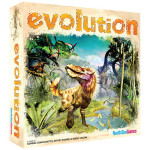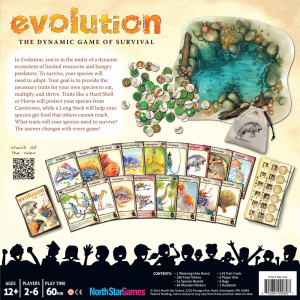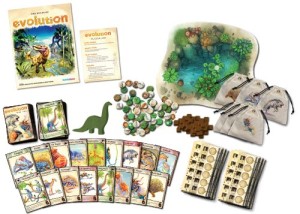Unplugged: Evolution (Boardgame)
 In Evolution, players shepherd their species through a progressively more competitive environment. Get your species to live long and prosper, measured by one’s food intake over the course of the game, and you win the game. Limited food, players creating carnivorous species, and subsequent adaptation to avoid them, creates a fun, fast playing game suitable for “serious” boardgamers as well as a family game night.
In Evolution, players shepherd their species through a progressively more competitive environment. Get your species to live long and prosper, measured by one’s food intake over the course of the game, and you win the game. Limited food, players creating carnivorous species, and subsequent adaptation to avoid them, creates a fun, fast playing game suitable for “serious” boardgamers as well as a family game night.
Evolution
Designers: Dominic Crapuchettes, Dmitry Knorre, Sergey Machin
Publisher: North Star Games
Ages: 10+
Players: 2-6
Time: 60 mins
(Review copy provided by North Star Games)
The the theme of Evolution is quite simple. Each player starts with a basic species, represented by a body size and population, and tries to grow that (and additional) species throughout the game. At the end of each round, a species must eat food equivalent to its population or have its population reduced. The overall goal of the game is to finish with the most food eaten (plus the total population of all your species.)
Each round, players are dealt cards they can use to improve their species. First, one card is donated to the central feeding pool (more on that later) and the rest of the cards can be used in one of four ways. Any card can be discarded to increase a species population, increase a species body size, or used to create an additional new species to manage. In order to win, a player needs to be able to manage several species through the game in order to garner enough food to win. The final use of a card is to play it on a species to give it new adaptations. Up to three adaptations can be on a species at a time. Most of these allow a species to improve its food gathering abilities (either from additional sources or through more efficient methods) or allow a species to avoid predators. One of the adaptation cards causes a species to become a predator. Predators do not eat from the central pile, they prey on other species instead. They must be larger in body size than the “prey” (thus the usefulness of body size) and be able to get through the prey’s defenses. For example, a climbing predator could eat a smaller, climbing species. When the carnivore feeds, it takes food equal to the prey’s body size (so eating larger animals will feed your predator population more quickly.) In order to combat other species defenses, there are several predator-only adaptations that can counteract specific prey defenses.
After players finish spending their cards (players are allowed to keep unspent cards for later), the cards donated to the central feeding pool are revealed. Each card has a listed “food value” and food tokens equal to the sum of those values are placed in the central area. One food is revealed, players then take turns grabbing one food token from the central area to feed their species. Carnivores attack the opponent species instead of removing tokens from the middle. Once every species is fed (as much as it can), players reduce any species to a population level equal to the amount it was fed. All food tokens are then removed and placed in a player’s scoring bag, to be added up at the end of the game. If there are still extra food tokens in the central feeding pool, they remain there for the next round. Play continues until the adaptation card deck runs out and then the final round finishes out before final scoring.
The game falls right in a sweet spot for me, easy enough to teach new players but keeping enough strategy to prevent it from becoming too stale. The game plays up to 6 players, which would normally drag the game out, but I found it still moved along at a brisk pace if players use the alternate rules where each player plays their species’ “upgrades” simultaneously. I prefer the quicker play so much that I prefer to play with simultaneous upgrades for any number of players. It is a sacrifice of some deeper strategy for faster play but I can live with that. (For example, – one might wait to see how large a carnivore might grow before deciding on the body size of one’s own species.)
The components are nice and sturdy and the art is engaging and doesn’t get in the way of the mechanics. In fact, the art and style of the game bring out the theme of the game. Since the theme ties in so nicely with the gameplay, the result is a moderately complex game that is quite easy to understand and play.
My only reservation about the game lies in the play balance. The game is now in its second edition, where several of the adaptation cards have been slightly changed for better game balance. While these have gone a long way to help spruce up weaker cards and make each adaptation worthwhile, I can still find times when I just don’t feel like my cards provide me with good options. Thankfully, the ability to improve things by simply discarding cards (for body size, population, or new species) helps to limit the issues of a poor hand.
Even so, I find some cards can be extremely powerful in some situations. Fertile, a card giving a free population growth if there is leftover food from the previous round, can be extremely powerful if used early in the game where food tends to be less tight. There are several very good card combinations where several species can effectively work together to feed quickly and/or protect each other. However, since they are card combinations, it can be frustrating to go for several turns without finding a good combination to put into play.
I have also found carnivores to be a very difficult species type to play. They shine best when food is scarce, since they don’t rely on the central food pool. However, later in the game is when species tend to already have more effective feeding strategies and defenses. At first, one might think carnivores have the additional benefit of keeping the game leaders in check, but in practice a well established species (large population and body size) is hardly bothered by the occasional attack, since it will feed a carnivore after a single “bite”. Group-think is partly to blame for this. In most of my games, players have shied away from bringing carnivores into play, in favor of alternative and quicker feeding strategies along with inter-species defenses. This results in a game where carnivores become a very inefficient species at gathering food. I have yet to play in a game where there is a significant number of carnivores (not for lack of trying as I have been experimenting with them to try to figure out how to make them more effective), but most of my dozen or so plays of the game, the winners had no carnivores at all.
While that sounds like a major gripe, it is only a minor one. The game remains fun to play, and the large number of adaptations available provide a player with new combinations with which to experiment, making it fun over repeated games as well. If the games sounds interesting, the new second edition is available for preorder through a kickstarter for a new expansion focused on species with the ability to fly.
Verdict:
Designers walk a knife edge when trying to create a boardgame that is approachable enough for family fun and yet strategic enough to capture the attention of experienced boardgamers. One key aspect of that struggle lies in connecting the theme of the game to its mechanisms. Evolution elegantly captures the essence of its theme and manages to balance on that thin line between approachable and depth to provide a very satisfying game playable in about an hour.
Kid Factor: The game has a colorful and fun theme and fairly simple mechanics making it a very nice family game. I’ve played it successfully with an 8 year old, and it might work a bit younger. The game requires reading of the adaptation card text, but once the adaptations are learned the pictures would be enough to signal which cards do what. While carnivores are part of the game, they are only a smaller part which keeps the direct player vs player conflict to a minimum, always a bonus for a family game. Quick play also allows one to complete an entire game on those rare school nights where no one has any homework left to do. All in all, the game will remain high on my go-to boardgames for family-friendly play.







May 5th, 2015 at 6:41 pm
Hi Matt! Thanks for the in-depth review. We really appreciate it.
Carnivores are the most difficult strategy to master, but they are also one of the more effective strategies. The key to playing Carnivores is to pay attention to the HUGE 1st player marker. The time to play a Carnivore is when you are the last player of the round. That gives you the chance to see what others have played. Oh!! Now I understand. Your decision to do simultaneous play changes this advantage gained by Carnivores. The only other thing you should consider is farming one of your own animals to ensure the survival of your Carnivore in case there isn’t other food available. A species of Body Size 4 with Fertile is a great source of food.
One of my favorite food engines is a scavenger at the front of a cooperation chain in conjunction with a carnivore, 3 or 4 unprotected species designed to be eaten, and playing low food cards.
I hope you’re enjoying all of the possibilities this game has to offer.
Cheers!
Dominic
May 5th, 2015 at 6:43 pm
I agree the turn-based sequence of upgrades really helps out the carnivore, and it is a good point.
I don’t think anyone in my playing groups went for building species (or even one) designed to be eaten… should be an interesting take…